
When Hillcrest Christian College had an open day last year, more than 700 people showed up.
As pleased as executive principal Brendan Kelly was to see so much interest in his school, it was a problem.
“We wouldn’t have had 70 places, so it’s a bit hard; what do you do with that?” he said.
Growth has been good for the low-fee independent school, but it has also brought its own set of challenges.
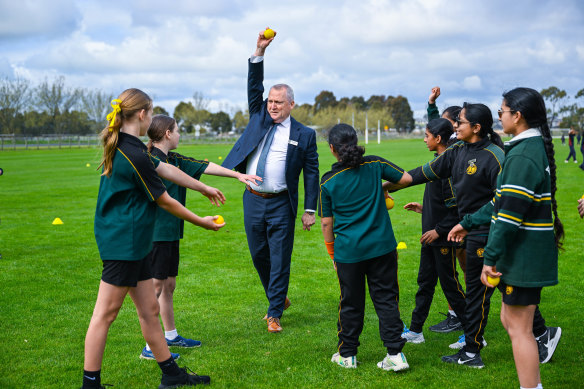
Brendan Kelly plays cricket with students at Hillcrest Christian College.Credit: Joe Armao
Last month, the school finally had a set of temporary traffic lights installed on the increasingly congested road outside its front gates, after months of lobbying the council. Families no longer have to do what Kelly dubbed the “dash of death” at pick-up and drop-off times.
Kelly’s school sprawls over 140 acres of former farmland in Clyde North, a booming suburb on Melbourne’s absolute fringe.
The school has an equestrian centre with 17 horses, a small marsh where the migratory Latham’s snipe lives, and a bush reserve that backs onto a bend in Cardinia Creek, where the Bunurong people previously camped.
The grounds are so big, he uses his green vintage Volkswagen Kombi to get around.
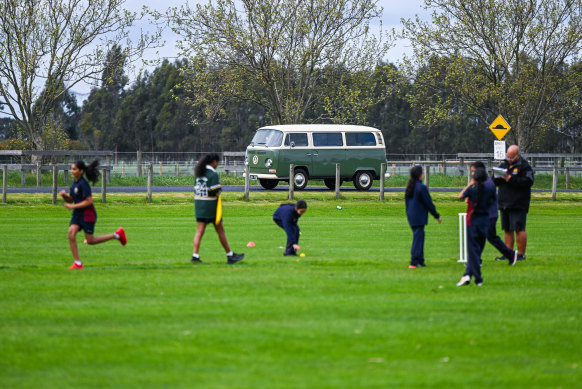
Hillcrest Christian College executive principal Brendan Kelly drives a vintage Kombi around the school’s expansive grounds.Credit: Joe Armao
The generous open spaces give the school a rural flavour, but suburbia is pressing in hard.
A row of new houses rises over one fence, and a billboard just went up on the edge of the paddock on its southern boundary, which was full of cows six months ago but has just been marked out for housing lots.
“This is that place to discover and call home,” the billboard reads.
Kelly said the school is determined to protect its bush reserve as a local green wedge for its expanding cohort of students to connect with nature.
“If you look at the houses here, they don’t have backyards, they don’t have trees to climb.”
More than 2100 students are split across the school’s two campuses, almost double the number of 10 years ago.
Hillcrest is an open-entry school, and it has become increasingly multicultural and multi-faith as it has grown.
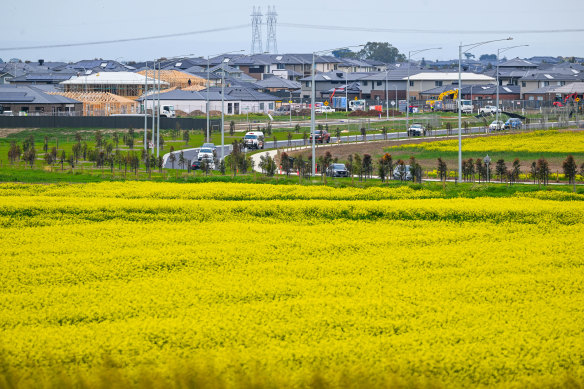
Urban growth and farming collide on Melbourne’s absolute fringe in Clyde North.Credit: Joe Armao
Ten years ago, one in four students came from a non-English-speaking background. Today, it is one in two. In this way, the school simply reflects the suburb it is part of.
Clyde North is young, multicultural, married and heavily mortgaged. Just over half the population was born outside Australia, according to census data. The median age is 30, eight years below the state and national average, and 60 per cent of people are married (the state average is 46.8 per cent).
Two-thirds of homes are mortgaged; almost double the statewide average.
When planners and politicians talk about urban sprawl, they are talking about places like Clyde North, 50 kilometres south-east of Melbourne. Trains don’t run there, the freeway journey takes an hour in off-peak traffic, and the local roads are gummed up by continual roadworks.
And yet people keep moving there. Between 2011 and 2021, its population exploded from 769 to 31,681 people, making it one of the fastest-growing suburbs in Australia.
Loading
Victoria’s migrant intake for 2022-23 was a record 167,500 people, according to data published by the Australian Bureau of Statistics this month – and 90 per cent of those arrivals moved to Melbourne.
The state’s population also ticked above 7 million in June or July, ABS demography director Phil Browning said.
Melbourne’s population swelled by 42 per cent between 2001 and 2021, and most of those extra bodies moved into the city’s outer-growth corridors, which absorbed more than 900,000 new people. Established suburbs grew by a fraction of that.
For example, the City of Casey, which includes Clyde North, grew by 219,000 people between 2000 and 2023. Inner-city Boroondara, which has frequent trains, trams and several sought-after schools, grew by just 19,640 people.
It’s a pattern of growth the Victorian government wants to flip. But to do so, it will need to turn around years of migration patterns that have driven housing growth in the outer suburbs, where the overseas-born families that dominate detached house sales in Melbourne overwhelmingly go looking for a home.
The ‘migration lag effect’
The Victorian Labor government’s housing statement, released a year ago, reaffirmed a target of 70 per cent of new homes to be built in established areas, with the remaining 30 per cent in growth areas. It will require building a million new homes in established suburbs by 2050.
Local councils across Melbourne have been given draft housing targets as part of the government’s revamped Plan for Victoria, which will be finalised early next year.
But Melbourne’s largest council, the City of Casey, has warned the government that it will struggle to find enough people, particularly migrants, who are willing to move into high-density homes.
“Growth areas offer the affordable housing and choice that cannot be provided in the established areas targeted for 70 per cent of new homes in Victoria’s Housing Statement,” the City of Casey argued in its submission to Plan for Victoria.
The council said large families looking for family homes would remain priced out of inner and middle suburbs.
“The Victorian development industry has clearly articulated the costs of providing affordable family-sized dwellings in established areas, which is not an option for larger families and culturally and linguistically diverse communities.”
The warning is backed up by a report on migration and property trends by the Australian Population Research Institute. The August 2024 report, titled The housing crisis in Sydney and Melbourne – new strategies to fix it, urges the government to grapple with what it calls the “migration lag effect”.
The lag effect is the authors’ term for their finding that the biggest group of homebuyers by far in Australia’s two largest cities is migrants who moved to Australia between 10 and 15 years ago.
This group’s preference is also overwhelmingly for a detached home in the outer suburbs.
In Melbourne, 15.56 per cent of homes bought between 2016 and 2021 were bought by people who had moved to Australia 10 to 15 years ago, compared to 7.36 per cent for Australian-born buyers.
These migration and property patterns mean that demand for a home on Melbourne’s fringes is baked in for years, no matter what government policies are brought in today, co-author David McCloskey said.
Between 2011 and 2021, the population of Clyde North exploded from 769 to 31,681 people, making it one of the fastest-growing suburbs in Australia.
“More than half of the people who’ve moved to Australia have actually started as international students, and if you look at their age range, then they’re essentially coming into the age where they’ve started to form relationships, families, 10 to 15 years after they’ve arrived,” he said.
Continued high intakes of international students will ensure that this pattern continues, McCloskey said.
“We are actually turbocharging the demand for entry into family-friendly housing.”
The institute’s report proposes a range of solutions for Australia’s housing crisis, including one that cuts against planning orthodoxy.
“The scale of the housing crisis is such that ‘the least-worst’ option to improve supply of affordable house and land options is to allow increased urban development on the city fringe,” it says.
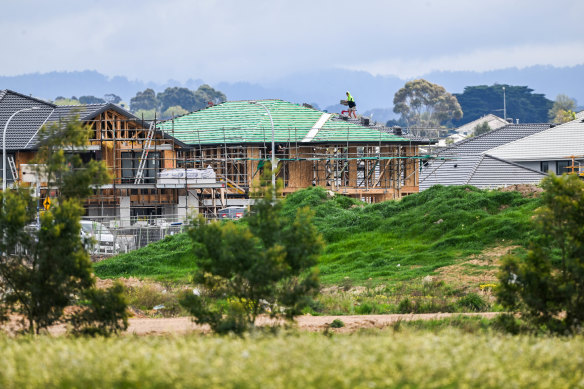
Demand for housing on Melbourne’s fringe is dominated by migrants, new research has found.Credit: Joe Armao
It’s not advice the government appears keen to take.
Treasurer Tim Pallas and Planning Minister Sonya Kilkenny this month visited Hawthorn, in the heart of Boroondara, to announce their approval of a development that epitomises the government’s housing agenda: 365 homes on a large vacant site once owned by the University of Melbourne.
The development will include a mix of one-, two- and three-bedroom homes, and 10 per cent affordable homes, making it eligible for fast-tracking under the government’s Development Facilitation Program.
New homes on the urban fringe require taxpayer investment in new roads, transport, schools, hospitals and services, Pallas said, noting that those amenities already exist in places such as Hawthorn.
Kilkenny said the outer suburbs had “taken a lot of the pressure of recent housing growth”.
“We need to spread that housing. We need to unlock areas in established Melbourne and make these places available for more Victorians to call home,” she said.
‘More people is good’
Casey was one of just two councils across Melbourne that had a housing approval rate in the past five years that would put it on track to meet the government’s housing targets.
Among those who moved to the area is Bhumika Raval, who migrated from India to Australia with her husband 12 years ago.
Both were international students at the time. They lived in inner-city apartments for several years but were set on one day buying a family-sized house.
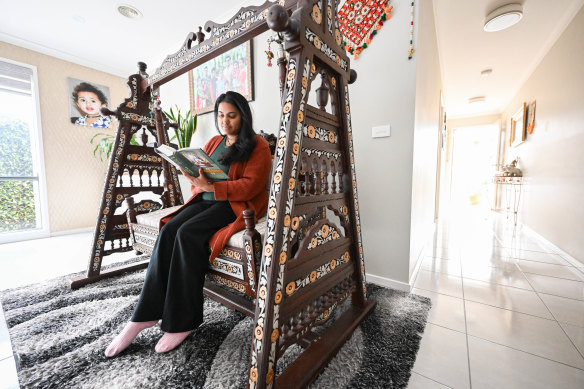
Bhumika Raval inside her family’s house in Clyde, one of Melbourne’s fastest-growing suburbs.Credit: Joe Armao
They moved to Clyde for no other reason than it fit within their budget. Now that they are there, they have found their people and are set on staying.
“It’s a safe suburb. My kids can play on the street, people are nice, and they watch out for them when they drive,” Raval said.
She doesn’t mind that the area’s population is exploding.
“The population has grown a lot, but I’m not worried about that. Having more people is good.”
Kelly, the Hillcrest principal, has watched the area’s huge growth and struggles to see how any housing policy will slow it down.
“It’s hard to stop a tidal wave,” he said. “People vote with their feet, whatever we plan for them to do.”
The Morning Edition newsletter is our guide to the day’s most important and interesting stories, analysis and insights. Sign up here.



























